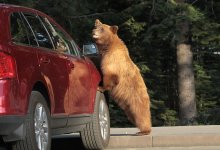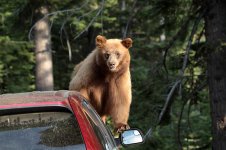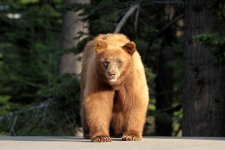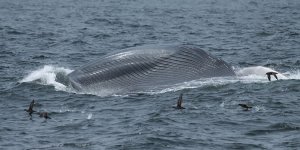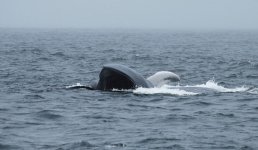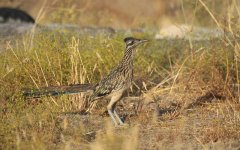-
Welcome to BirdForum, the internet's largest birding community with thousands of members from all over the world. The forums are dedicated to wild birds, birding, binoculars and equipment and all that goes with it.
Please register for an account to take part in the discussions in the forum, post your pictures in the gallery and more.
You are using an out of date browser. It may not display this or other websites correctly.
You should upgrade or use an alternative browser.
You should upgrade or use an alternative browser.
Road Trip USA. Part One, Salton Sea to Arctic Ocean. (1 Viewer)
- Thread starter Jos Stratford
- Start date
More options
Who Replied?
3 July. Monterey Bay & West Pinnacles.
....
Then inland again, destination for the evening Pinnacles National Monument ...
Just to finish this day off...
Enough of the relative cools of the coast, time to head back inland for a little more exploration. One of my favourite localities in California is the Pinnacles National Monument, a land of canyons, monoliths and spires rising out of arid chaparral. A quaint campsite sits on the east side, my destination for the evening, but I began on the less visited western edge. Superb for raptors, a swirl of Turkey Vultures hugged the higher peaks, a pair of Prairie Falcons in their midst. American Kestrels and a White-tailed Kite hunted the lower slopes, Red-tailed Hawks too, plus a Golden Eagle over a low hillside. Pinnacles however has an even bigger star – one of the sites for the reintroduction of Californian Condors, several now reside in the area and it wasn’t long before one of these mighty birds drifted into view, circling with the Turkey Vultures and turning them into virtual midges. Impressive bird. White-throated Swifts also zoomed about.
A little extra exploring added quite a number of additional dry country species – Californian Quails, Acorn Woodpeckers, Oak Titmice, Wrentits, etc, as well as one Greater Roadrunner and my first Bewick’s Wren of the trip. It was now approaching sunset, so I began the relatively long drive round to the west side. Good for mammals on route – Brush Rabbit, Desert Cottontail, Black-tailed Jack Rabbit and, trotting across the road, three Feral Hogs. Perfect look-alikes for the Wild Boar of Europe, these are apparently fairly common in parts of California now.
At the campsite in East Pinnacles, now completely dark, a Raccoon rounded the evening off, a lone individual sniffing around.
wolfbirder
Well-known member
Sounds wonderful Jos. Love to see one of those Condor's, plus the kite too.

4 July. Pinnacles & Ano Nueva.
4th July, American Independence Day and my final day in California. To celebrate, I was up at dawn enjoying a splendid Bobcat sitting in the grass taking in the first sun rays of the morning. That was pleasant, the cat simply gazing across at me with barely a care in the world. Desert Cottontails hopping about too, along with Black-tailed Jack Rabbits, Californian Ground Squirrels, a pair of Merrian’s Chipmunks on the rocks and, at the smaller end of the scale, one Brush Deermouse and a surprisingly chunky Dusky-footed Wood Rat. Not bad for birds too, a Northern Pygmy Owl had been calling prior to dawn and now the campsite was full of California Quails, Acorn Woodpeckers and Western Bluebirds, with Wild Turkey, Ash-throated Flycatcher and numerous Western Scrub-Jays also seen. A hike up a mountain trail in the already burning Californian sun added a few more birds, including White-breasted Nuthatch, Rock Wren, Black Phoebe and Wrentit, while Yellow-billed Magpie was added in pastures as I departed the area mid-morning.
Needing to dump my car in Sacramento in the late evening, I had ideas of doing the touristy thing in the afternoon and paying a visit to San Francisco and the famous Golden Gate Bridge. I had not taken account of the date – on the 4th July, every Tom, Dick and Harry of the country takes to the roads, pouring out onto the beaches and generally reveling in the enjoyment of sitting in traffic queues. As I neared San Francisco, in already fairly heavy traffic along the scenic Highway 1, radio stations were falling over themselves to detail the tailbacks and delays in almost all quarters of the city, not least on the bridges into and out of the Bay area. Na, thought I, that is not for me. A rapid change of plan and instead I turned into the Ano Nuevo State Reserve, another key breeding site for Northern Elephant Seals. What I did not know however was that it also supports a massive colony of Steller’s Sea Lions too – several thousand individuals strong, the colony is situated on a large island a little way offshore and is the only breeding site for this species south of Alaska. A fantastic sight it is, Elephant Seals on the lower portions of the island, a scrum of Steller’s Sea Lions on the top, complete with thousands of breeding Brandt’s Cormorants and a bevy of Brown Pelicans too. On the waters around, a Sea Otter was bobbing in the surf, a few Western Grebes sat and a pair of Pacific Loons completed the picture.
Elsewhere on the reserve, a small cliff held Pigeon Guillemots and a few pairs of Pelagic Cormorants, while the coastal scrub supported Californian Thrasher, White-crowned Sparrows and a White-tailed Kite. Also, Tree Swallows, Spotted Towhees, Song Sparrow and Brewer’s Blackbird.
And with that, the Californian leg of my journey was over, plenty of birds logged and a splendid 40 species of mammal recorded. Three hours later, I had dropped my car off in Sacramento and was heading for the Amtrak station, a train would take me far to the north.
5 July. Amtrak North.
Boarding a little after midnight, a 20 hour sedate trundle up the Pacific coast on an Amtrak train from Sacramento in California to Seattle in Washington. With panoramic windows and even an observation coach, this was no naff train - a rather more pleasant affair than I had been expecting. Passed through northern California during the hours of darkness, then the meadows, marshes and endless forests of Oregon from early morning, entering Washington mid-afternoon.
Picturesque throughout. Not too bad for spotting birds too – a total of 25 species noted, the highlights being White Pelicans, a couple of Bald Eagles and a Mountain Bluebird in Oregon, plus Wood Duck, Belted Kingfisher and Cedar Waxwing in Washington.
Arrived in Seattle just before 9 p.m., zipped up to the airport and collected a rental car for the next mini-segment of my trip, a one day stop in the North Cascades.
4th July, American Independence Day and my final day in California. To celebrate, I was up at dawn enjoying a splendid Bobcat sitting in the grass taking in the first sun rays of the morning. That was pleasant, the cat simply gazing across at me with barely a care in the world. Desert Cottontails hopping about too, along with Black-tailed Jack Rabbits, Californian Ground Squirrels, a pair of Merrian’s Chipmunks on the rocks and, at the smaller end of the scale, one Brush Deermouse and a surprisingly chunky Dusky-footed Wood Rat. Not bad for birds too, a Northern Pygmy Owl had been calling prior to dawn and now the campsite was full of California Quails, Acorn Woodpeckers and Western Bluebirds, with Wild Turkey, Ash-throated Flycatcher and numerous Western Scrub-Jays also seen. A hike up a mountain trail in the already burning Californian sun added a few more birds, including White-breasted Nuthatch, Rock Wren, Black Phoebe and Wrentit, while Yellow-billed Magpie was added in pastures as I departed the area mid-morning.
Needing to dump my car in Sacramento in the late evening, I had ideas of doing the touristy thing in the afternoon and paying a visit to San Francisco and the famous Golden Gate Bridge. I had not taken account of the date – on the 4th July, every Tom, Dick and Harry of the country takes to the roads, pouring out onto the beaches and generally reveling in the enjoyment of sitting in traffic queues. As I neared San Francisco, in already fairly heavy traffic along the scenic Highway 1, radio stations were falling over themselves to detail the tailbacks and delays in almost all quarters of the city, not least on the bridges into and out of the Bay area. Na, thought I, that is not for me. A rapid change of plan and instead I turned into the Ano Nuevo State Reserve, another key breeding site for Northern Elephant Seals. What I did not know however was that it also supports a massive colony of Steller’s Sea Lions too – several thousand individuals strong, the colony is situated on a large island a little way offshore and is the only breeding site for this species south of Alaska. A fantastic sight it is, Elephant Seals on the lower portions of the island, a scrum of Steller’s Sea Lions on the top, complete with thousands of breeding Brandt’s Cormorants and a bevy of Brown Pelicans too. On the waters around, a Sea Otter was bobbing in the surf, a few Western Grebes sat and a pair of Pacific Loons completed the picture.
Elsewhere on the reserve, a small cliff held Pigeon Guillemots and a few pairs of Pelagic Cormorants, while the coastal scrub supported Californian Thrasher, White-crowned Sparrows and a White-tailed Kite. Also, Tree Swallows, Spotted Towhees, Song Sparrow and Brewer’s Blackbird.
And with that, the Californian leg of my journey was over, plenty of birds logged and a splendid 40 species of mammal recorded. Three hours later, I had dropped my car off in Sacramento and was heading for the Amtrak station, a train would take me far to the north.
5 July. Amtrak North.
Boarding a little after midnight, a 20 hour sedate trundle up the Pacific coast on an Amtrak train from Sacramento in California to Seattle in Washington. With panoramic windows and even an observation coach, this was no naff train - a rather more pleasant affair than I had been expecting. Passed through northern California during the hours of darkness, then the meadows, marshes and endless forests of Oregon from early morning, entering Washington mid-afternoon.
Picturesque throughout. Not too bad for spotting birds too – a total of 25 species noted, the highlights being White Pelicans, a couple of Bald Eagles and a Mountain Bluebird in Oregon, plus Wood Duck, Belted Kingfisher and Cedar Waxwing in Washington.
Arrived in Seattle just before 9 p.m., zipped up to the airport and collected a rental car for the next mini-segment of my trip, a one day stop in the North Cascades.
Last edited:

Does this mean you got to Barrow without being eaten by Grizzlies?
BTW words fail me with the Yosemite Bear!
Photographs of the latter bear to follow, one bear 'incident' on route to the top
chris butterworth
aka The Person Named Above
I've just realised - you'll get to the top of Alaska at the same time Polar Bears are feeling really hungry. More 'Jack London' stuff to come? :eek!: Stay safe mate.
Chris
Chris
michaelboustead
Well-known member
I have only seen one Polar Bear in my life and it was BIG. I love the posts-please do nothing Jos Like.

6 July. North Cascades.
Cruising the Cascades in an open convertible, what luxury! I had actually booked an economy class car, but the rental office only had a ‘truck’ or convertible, so imagining a truck was some seven-ton monster, I opted for the rather low-slung convertible, not a car I would normally choice.
So, with top down, out onto the mountain roads I went, a positive traffic hazard I’m sure I was, now able to scan the skies in all directions. I did pick up a few good birds this way though – several Vaux’s Swifts, a day-flying Common Nighthawk buzzing around a cliff top and a Band-tailed Pigeon amongst the haul. First stop for proper birding however was in a patch of deciduous woodland aside a river in the relative lowlands. Following a gravel track, there were many birds of interest: Rufous Hummingbirds zipping about, Swainson’s Thrushes singing from the undergrowth, a pair of MacGillivray’s Warblers active, a single American Redstart and a Cedar Waxwing for starters, plus a whole bunch of other birds including both Olive-sided and Hammond’s Flycatchers. The bird I had been seeking though was a far more humble affair – for some reason I particularly wanted to see a Pacific Wren, a recent split and a bird essentially identical to the species found in Europe. It took quite a while, but then I heard a characteristic trill flowing from a dense tangle of fallen trees and, after a few minutes of stumbling across slippery trunks and moss-covered rocks, I was standing beneath a tree with the Pacific Wren in full voice just above. Success, a nice bird indeed, but I’m not sure I would give it a second glance if it were to turn up in Europe!
From there, I turned my attentions to the higher altitudes, a scenic tour taking me towards the snow-capped peaks and forested slopes. No particular birds on my radar here, but I did have desires to find Townsend’s Chipmunk, Hoary Marmot and Mountain Goat. I soon found that the road didn’t go high enough and the latter two would need a hike to high altitude pastures, something I did not have time to do, but the chipmunk should have been easy enough. It wasn’t! After numerous stops and several checks of campsites and picnic areas, I was close to giving up when finally I heard the chirp of a chipmunk in a parking area close to Washington Pass, the highest point on the road. Several Grey Jays were patrolling the car park, a Clark’s Nutcracker too, but very quickly I located my little beastie, rummaging round under some pines, one Townsend’s Chipmunk. Atop a pine adjacent, a splendid male Western Tanager added a positive splash of colour.
On route down, another Townsend’s Chipmunk darted across the road and I also found two American Picas (as well as an American Marten dead on the road), but my time was up, I needed to drop the car off and get to the ferry port. My travels in the Lower 48 had reached their end, ahead the real adventures were about to begin, the great journey north through Alaska.
Cruising the Cascades in an open convertible, what luxury! I had actually booked an economy class car, but the rental office only had a ‘truck’ or convertible, so imagining a truck was some seven-ton monster, I opted for the rather low-slung convertible, not a car I would normally choice.
So, with top down, out onto the mountain roads I went, a positive traffic hazard I’m sure I was, now able to scan the skies in all directions. I did pick up a few good birds this way though – several Vaux’s Swifts, a day-flying Common Nighthawk buzzing around a cliff top and a Band-tailed Pigeon amongst the haul. First stop for proper birding however was in a patch of deciduous woodland aside a river in the relative lowlands. Following a gravel track, there were many birds of interest: Rufous Hummingbirds zipping about, Swainson’s Thrushes singing from the undergrowth, a pair of MacGillivray’s Warblers active, a single American Redstart and a Cedar Waxwing for starters, plus a whole bunch of other birds including both Olive-sided and Hammond’s Flycatchers. The bird I had been seeking though was a far more humble affair – for some reason I particularly wanted to see a Pacific Wren, a recent split and a bird essentially identical to the species found in Europe. It took quite a while, but then I heard a characteristic trill flowing from a dense tangle of fallen trees and, after a few minutes of stumbling across slippery trunks and moss-covered rocks, I was standing beneath a tree with the Pacific Wren in full voice just above. Success, a nice bird indeed, but I’m not sure I would give it a second glance if it were to turn up in Europe!
From there, I turned my attentions to the higher altitudes, a scenic tour taking me towards the snow-capped peaks and forested slopes. No particular birds on my radar here, but I did have desires to find Townsend’s Chipmunk, Hoary Marmot and Mountain Goat. I soon found that the road didn’t go high enough and the latter two would need a hike to high altitude pastures, something I did not have time to do, but the chipmunk should have been easy enough. It wasn’t! After numerous stops and several checks of campsites and picnic areas, I was close to giving up when finally I heard the chirp of a chipmunk in a parking area close to Washington Pass, the highest point on the road. Several Grey Jays were patrolling the car park, a Clark’s Nutcracker too, but very quickly I located my little beastie, rummaging round under some pines, one Townsend’s Chipmunk. Atop a pine adjacent, a splendid male Western Tanager added a positive splash of colour.
On route down, another Townsend’s Chipmunk darted across the road and I also found two American Picas (as well as an American Marten dead on the road), but my time was up, I needed to drop the car off and get to the ferry port. My travels in the Lower 48 had reached their end, ahead the real adventures were about to begin, the great journey north through Alaska.
Super report - look forward to Polar Bear sightings having just seen a few.

You're skipping all of Canada? Seems a shame.
Not Canadian waters however :t:

Now back in the comfy world of internet connections, etc, etc, reports and photographs should start flowing now....


birdboybowley
Well-known member.....apparently so ;)

Cool pics......
What is that car's wing-mirror made of ??!!
What is that car's wing-mirror made of ??!!
Farnboro John
Well-known member
Reverting to an earlier post, Maz and I got Steller's Sealion at Ano Nuevo too - just one huge male lounging on the lower part of the island out-of-season (early June).
John
John
Users who are viewing this thread
Total: 2 (members: 0, guests: 2)






